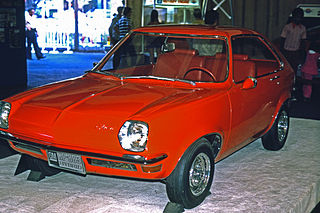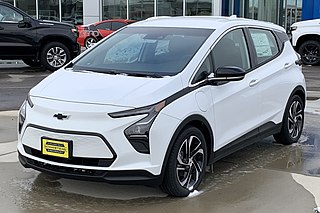
The Opel Astra is a compact car/small family car (C-segment) developed and produced by the German automaker Opel since 1991, currently at its sixth generation. It was launched in September 1991 in hatchback, saloon, and estate forms. A panel van and a convertible also appeared in the early 1990s. These bodystyles were later followed by a coupé in 2004, and the sporty Astra OPC appeared in 2005. The Twin Top retractable hardtop convertible replaced the soft top convertible in 2006, while the Caravan was rebadged Astra Sports Tourer from 2009 to 2021. The car slots between the smaller Corsa and the larger Insignia.

The Opel Vectra is a mid-size car that was engineered and produced by the German automaker Opel from 1988 until 2008. Available in saloon, hatchback and estate body styles, the Vectra was also sold by the Vauxhall marque in the United Kingdom as the Vauxhall Cavalier from 1988 to 1995 and then as the Vauxhall Vectra from 1995 to 2008, and it was also sold by Holden in Australia as the Holden Vectra, and by Chevrolet in Latin America as the Chevrolet Vectra.

The Opel Zafira is a seven-seater car manufactured and marketed across three generations from 1999-2019 by Opel, using the Astra platform. It has a front engine, front-drive, five door, high-roof, multi-purpose vehicle (MPV) design.

The Saturn Vue is a compact SUV that was sold and built by Saturn, and it was Saturn's best-selling model. It was the first vehicle to use the GM Theta platform when it was introduced in 2001 for the 2002 model year. The Vue was later facelifted for the 2006 model year. A second generation model was launched in 2007 for the 2008 model year as a rebadged Opel Antara. The Vue production in North America ended as GM wound down the Saturn brand during its 2009 reorganization.

The Chevrolet Malibu is a mid-size car manufactured and marketed by Chevrolet from 1964 to 1983 and since 1997. The Malibu began as a trim-level of the Chevrolet Chevelle, becoming its own model line in 1978. Originally a rear-wheel-drive intermediate, GM revived the Malibu nameplate as a front-wheel-drive car in February 1997.

The Chevrolet Sail is a subcompact car produced by General Motors though its SAIC-GM joint venture in China. Launched in 2001, it was sold as the Buick Sail in China in both in sedan and wagon form which were both based on Opel Corsa B. Following the introduction of the Chevrolet brand in China in 2005, the car received a facelift and its name was changed to Chevrolet Sail and Sail SRV.

The Chevrolet Spark is a city car manufactured by General Motors's subsidiary GM Korea, currently in its fourth generation. The vehicle was initially developed by Daewoo and was introduced in 1998 as the Daewoo Matiz. In 2002, General Motors purchased Daewoo Motors, which had the vehicle being marketed with several GM marques and nameplates.

The Daewoo Lacetti is a compact car manufactured and marketed globally by GM Korea since 2002. The first-generation Lacetti was available as a four-door sedan and five-door station wagon, styled by Pininfarina—and five-door hatchback styled by Giorgetto Giugiaro. The sedan and wagon were marketed as the Daewoo Nubira in some European markets and as the Suzuki Forenza in North America. The hatchback, was introduced in 2004 and marketed as Daewoo Lacetti5 in South Korea, Suzuki Reno in the United States. After the 2004 model year, it was marketed as Chevrolet Nubira and Lacetti in Europe.

The Opel Antara is a compact crossover SUV which was marketed by Opel from 2006 to 2015. Based on the Theta platform, the Antara closely shared its underpinnings and powertrains with the Chevrolet Captiva. However, it only offered five seats instead of seven, and features a different exterior and interior design. Sales commenced in November 2006, as the indirect successor to the Isuzu-based Frontera range.
BAS is a category of automotive parallel hybrid technology that uses an electric motor to contribute power to the internal combustion engine's crankshaft via a serpentine belt. By mounting this motor generator unit in the conventional location traditionally used for the standard automotive alternator, it permits a low-cost method of adding mild hybrid capabilities such as start-stop, power assist, and mild levels of regenerative braking. BAS differ from other mild hybrid systems as they are not run off the vehicle's crankshaft.
Hybrid vehicle drivetrains transmit power to the driving wheels for hybrid vehicles. A hybrid vehicle has multiple forms of motive power.
Chevrolet Europe GmbH was a subsidiary company of GM Korea, founded in 2005, with headquarters in Zürich, Switzerland. It provided Chevrolet brand automobiles, most of which were made in South Korea for the European market.

The Chevrolet Volt is a plug-in hybrid manufactured by General Motors, also marketed in rebadged variants as the Holden Volt in Australia and New Zealand, Buick Velite 5 in China, and with a different fascia as the Vauxhall Ampera in the United Kingdom and as the Opel Ampera in the remainder of Europe. Volt production ended in February 2019.

In the late 1960s, General Motors Company directed its GM R&D and Pontiac divisions to develop concept mini-cars for urban drivers. GM developed the XP-883 an experimental plug-in hybrid car demonstrated by General Motors in 1969. Primarily intended as a commuter vehicle, the very small car had a fiberglass body with a design resembling the future Chevrolet Chevette. The two-door hatchback had seating for two adults and two children, though the children sat in rear-facing seats and would enter and exit through the tailgate. It was powered by the combination of a two-cylinder engine and a DC electric motor. Electricity was stored in six 12-volt batteries placed between the rear wheels. The related Pontiac concept was the Pontiac X-4 with a radical two stroke aircraft type radial engine.

The history of plug-in hybrid electric vehicles (PHEVs) spans a little more than a century, but most of the significant commercial developments have taken place after 2002. The revival of interest in this automotive technology together with all-electric cars is due to advances in battery and power management technologies, and concerns about increasingly volatile oil prices and supply disruption, and also the need to reduce greenhouse gas emissions. Between 2003 and 2010 most PHEVs on the roads were conversions of production hybrid electric vehicles, and the most prominent PHEVs were aftermarket conversions of 2004 or later Toyota Prius, which have had plug-in charging and more lead-acid batteries added and their electric-only range extended.

The Opel Insignia is a large family car developed and produced by the German car manufacturer Opel since 2008. Taking its name from a 2003 concept car, the model line serves as the flagship Opel car line, slotted above the Astra and Corsa in size. The Insignia serves as the successor for both the Signum and Vectra model lines, replacing both vehicles under a single nameplate. Currently in its second generation, the model line is offered in four-door sedan/saloon body styles, five-door liftback, and as a five-door station wagon/estate.
Voltec, formerly known as E-Flex, is a General Motors powertrain released in November 2010. The Voltec architecture is primarily a plug-in capable, battery-dominant electric vehicle with additional fossil fuel powered series and parallel hybrid capabilities.

The Opel Corsa is a supermini car engineered and produced by the German automobile manufacturer Opel since 1982. Throughout its existence, it has been sold under a variety of other brands owned by General Motors and also spawned various other derivatives.

The second generation Chevrolet Volt plug-in hybrid electric compact car produced by General Motors under the Chevrolet brand. It debuted at the 2015 North American International Auto Show to replace the original Volt, on sale since 2010. Retail deliveries as a 2016 model year began in October 2015 in the U.S. and Canada, and it was released in Mexico in December 2015. Availability of the 2016 model was limited to California and the other 10 states that follow California's zero emission vehicle regulations. It went on sale as a 2017 model year in the rest of the U.S. in February 2016. Volt production ended on February 15, 2019.

The Chevrolet Bolt or Chevrolet Bolt EV is a battery electric subcompact hatchback produced by General Motors under the Chevrolet marque. It was developed and manufactured in partnership with LG Corporation. A rebadged European variant was sold as the Opel Ampera-e in mainland Europe, but was discontinued after 2018.


















